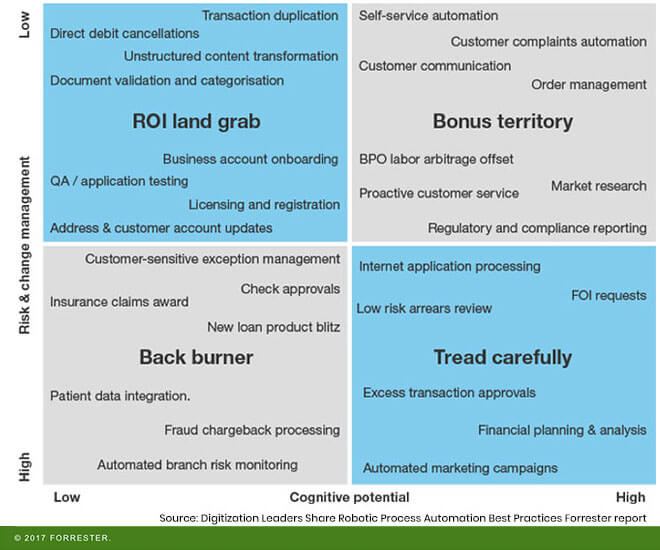The RPA Buying Patterns of Enterprises

More and more companies are under pressure to adopt digital strategies to leverage greater profits, drive high levels of customer satisfaction, and maintain footing in competitive marketplaces. And one of the key measures to adjusting to this ever-changing world of digitization is taking advantage of automation platforms. As such, consumer investments into one of these technologies — robotic process automation (RPA) — will increase to $1 billion within the next two years.
At least that’s what is predicted by the technology research and advisory company Gartner:
“By 2020, RPA tools will have evolved to include more types of functionality, such as AI software, but will experience strong downward pricing pressure. [...] 40% of very large global organizations will have adopted an RPA software tool, up from an estimated less than 10% today.”
Yet, despite having a basic understanding of the dimensions of RPA and a desire to implement the technology, many companies don’t know where to start — and it’s perfectly okay if your company doesn’t either. In order to help companies looking to automate to prioritize the various elements of RPA adoption, let’s consider the buying patterns of some of the enterprises that came before them.
Setting automation priorities
When adopting any new technology, enterprises generally base their buying patterns on operational and strategic priorities. And these priorities are set by weighing the trade-offs between the estimated costs (whether these be related to potential risk or financial, time, and labor expenses) and the expected benefits (whether these be related to streamlined operations, cognitive enhancement, faster supply chains, or better customer experience).
This behavior is no different for companies looking to implement RPA. Forrester suggests that:
“Not all RPA projects have the same potential. The best RPA software as well as] the best processes for RPA automation depend on their importance for operational excellence, customer value, ROI profile, cognitive support, and risk.”
As a result of these factors, Forrester presents a 4X4 matrix — at the intersection of risk and change management with cognitive enhancement — that drives the way enterprises prioritize processes for automation:
Bonus territory
The processes that fall within the “bonus territory” dimension are the low-hanging fruits that come at the lowest of costs and with the highest of benefits. Since the greatest returns on investment can be achieved with these processes, they should be given the highest priority for automation. Examples may, for instance, include the automation of market research processes, customer communication and self-service, order processing and management, as well as regulatory and compliance reporting.
ROI land grabs
The so-called “ROI land grabs” — which can involve the automation of document validation and categorization, business account onboarding, and transaction duplication — require little investment for success. At the same time, the automation of these processes does not constitute the same leap forward as the “bonus territory” does. But because benefits are benefits no matter how small, such processes are good for companies that value incremental change on their way to fully utilizing the potential of digitization.
Tread carefully
Generally weighed on an equal footing with “ROI land grabs,” the “tread carefully” can include the automation of marketing campaigns, financial planning, and internet application processing. Though this dimension is generally associated with greater financial inputs, employee investments, and time setbacks, success in these areas also comes with significant benefits and can be the path to achieving a strategic advantage. Because there are never any guarantees of success, enterprises generally tend to invest in the automation of these complex processes when they have the capacities (e.g. low employee utilization, high cash reserves) to take an operational risk.
Back-burner
The priorities put on the so-called “back burner” are categorized as such because they involve significant investments, though they also produce comparably lower benefits. The automation of these processes — which can, for example, include fraud chargeback processing, risk monitoring, and check approvals — generally happens when concerns in all others dimensions have already been addressed, allowing a company to reach its fullest potential.

Understanding priorities for automation success
Carefully evaluating what operations should be automated first, second, and lastly makes all the difference in the success of an automation project. According to professional services firm Genpact, approaching RPA methodologically [...]
“[...] will help quantify the value it can drive, and enable automation initiatives to deliver the expected results. The best approach is to start small, achieve quick wins, and build internal stakeholder confidence. As enterprises gain more experience, it becomes easier to scale RPA initiatives to address complex processes.”
As we’ve seen here, setting priorities is crucial in all stages of RPA: from choosing an RPA vendor to choosing what processes to automate. Enterprises should prioritize processes for automation by considering their potential outcomes, weighing the trade-offs between investments and rewards, and determining the best use-cases.
Though these priorities can differ from company to company and should be evaluated for each individual case, RPA experts and dedicated, internal project teams can build the foundation for an efficient RPA roll out. Even more so, a best practice is often to take these steps before choosing an RPA vendor. In this way, companies can establish their buying preferences in choosing an RPA vendor that is aligned with their priorities or has synergies to deal with multiple areas.

Product Marketing Content Writer, UiPath
Get articles from automation experts in your inbox
SubscribeGet articles from automation experts in your inbox
Sign up today and we'll email you the newest articles every week.
Thank you for subscribing!
Thank you for subscribing! Each week, we'll send the best automation blog posts straight to your inbox.



